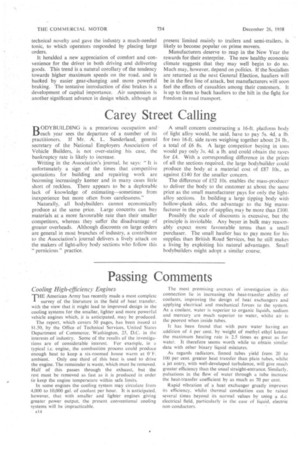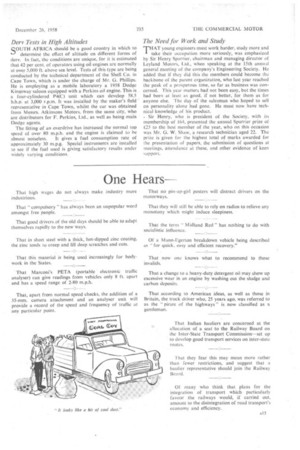Passing Comments
Page 16

Page 17

If you've noticed an error in this article please click here to report it so we can fix it.
Cooling High-efficiency Engines
THE American Army has recently made a most complete A survey of the literature in the field of heat transfer. with the view that it might lead to improved design in the cooling systems for the smaller, lighter and more powerful vehicle engines which, it is anticipated, may be produced.
The report, which covers 50 pages, has been issued at $1.50, by the Office of Technical Services, United States Department of Commerce, Washington, 25, D.C. in the interests of industry. Some of the results of the investigations are of considerable interest. For example, in a typical i.e. engine, the combustion process could produce enough heat to keep a six-roomed house warm at O'F.
ambient. Only one third of this heat is used to drive the engine. The remainder is waste, which must be removed. Half of this passes through the exhaust, but the rest must be removed as fast as it is produced in order to keep the engine temperature within safe limits.
In some engines the cooling system may circulate from 4,000 to 10,000 gal. of coolant per hour. It is anticipated, however, that with smaller and lighter engines giving greater power output, the present conventional cooling systems will be impracticable. The most promising avenues of investigation in this connection lie in increasing the heat-transfer ability of coolants, improving the design of heat exchangers and applying electrical and mechanical forces to the system. As a coolant, water is superior to organic liquids, sodium and mercury are much superior to water, whilst air is the poorest when inside tubes.
It has been found that with pure water having an addition of 4 per cent, by weight of methyl ethyl ketone the maximum heating rate is 2.5 tithes as great as for water. It therefore seems worth while to obtain similar data with other binary liquid mixtures.
As regards radiators, finned tubes yield from 20 to 100 per cent, greater heat transfer than plain tubes, whilst a jet entry, with well-developed turbulence, will give much greater efficiency than the usual straight-entrance.
pulsations in the flow of water through a tube increase the heat-transfer coefficient by as much as 70 per cent.
Rapid vibration of a heat exchanger greatly improves its efficiency, whilst thermal conduction can be raised several times beyond its normal values by using a d.c. electrical field, particularly in the case of liquid, electric non-conductors.
Dery Tests in High Altitudes
SOUTH AFRICA should be a good country in which to determine the effect of altitude on different forms of derv. In fact, the conditions are unique, for it is estimated that 42 per cent. of operators using oil engines are normally at over 5,000 ft. above sea level. Tests of this type are being conducted by the technical department of the Shell Co. in Cape Town, which is under the charge of Mr. G. Phillips. He is employing as a mobile laboratory a 1958 Dodge Kingsway saloon equipped with a Perkins oil engine. This is a four-cylindered P4(C) unit which can develop 58.5 b.h.p. at 3,000 r.p.m. It was installed by the maker's field representative in Cape Town, whilst the car was obtained from Messrs. Atkinsons Motors, from the same city, who are distributors for F. Perkins, Ltd., as well as being main Dodge agents.
The fitting of an overdrive has increased the normal top speed of over 80 m.p.h. and the engine is claimed to be almost noiseless. It gives a fuel consumption rate of approximately 30 m.p.g. Special instruments are installed to see if the fuel used is giving satisfactory results under widely varying conditions..
The Need for Work and Study
THAT young engineers must work harder, study more and I take their occupation more seriously, was emphasized by Sir Henry Spurrier, chairman and managing director of Leyland Motors, Ltd., when speaking at the 15th annual general meeting of the company's Engineering Society. He added that if they did this the members could become the backbone of the parent organization, who last year reached the peak of a prosperous time, so far as business was concerned. This year matters had not been ea.y, but the times had been at least as good, if not better, for them as for anyone else. The day of the salesman who hoped to sell on personality alone had gone. He must now have technical knowledge of his product.
• • Sir Henry, who is president of the Society, with its membership of 164, presented the annual Spurrier prize of £25 to the best member of the year, who on this occasion was Mr. CI; W. Shaw, a research technician aged 22. The prize is given for the highest total of marks awarded for the presentation of papers, the submission of questions at meetings, attendance at these, and other evidence of keen support.








































































